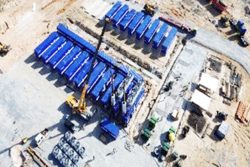Banks DIH Limited is actively seeking to acquire the property which currently houses the Guyana Relief Council to facilitate its continuing expansion since its current operations have outgrown Thirst Park.
“In keeping with vision of Banks DIH to move with the times, we will require space… there is just too much happening at Thirst Park and we don’t have the space to expand. We are planning for the year 2030, [so] we are asking the powers that be, to please actively consider our request to acquire the property next door, where we hope to continue our expansion program. We are willing to offer alternative accommodation at another suitable site without any dislocation of current operations,” Marketing Director George McDonald said yesterday.
McDonald was at the time speaking at the opening of the company’s New Vehicle Workshop, located at the Caribanks facility obliquely opposite Thirst Park.
The “property next door” referred to by McDonald is occupied by the Guyana Relief Council, which is located between the new Vehicle Workshop and the Banks DIH parking lot on the western side of the Ruimveldt Public Road. He explained that over the last two years, G$110 million had been spent to develop the northern side of the Caribanks complex into a 36,000 square foot workshop to provide technical support for the company’s fleet of 500 vehicles.
The property, which once belonged to the Ministry of Public Works’ Plant Maintenance Division, was acquired by Banks in 2001 and its development accelerated once it was recognized that the activities at Thirst Park had outgrown the available space.
McDonald further explained that since 2004, the company has been actively drafting plans to facilitate the provision of clean and reliable energy and has so far constructed specialised generation facilities. Currently, the workshop is located on the same lot as the 10 megawatt generating plant that enables Banks DIH to operate independent of the national grid.
The company, however, is still actively pursuing the development of alternative energy so as to reduce its carbon footprint.
The Waste Water Treatment plant, a requirement of the Coca Cola Company, and the Waste Plastic Treatment facility, are also located on this lot. Waste plastic generated from the manufacture of PET containers and damaged plastic decommissioned by the company are chipped and crushed at this plant before being sent off to recycling plants overseas.
Minister of State Joseph Harmon, speaking after McDonald, noted that while he was “not the power that be,” he had heard the request and was sure that the company and government can work together to achieve a reasonable outcome.
He hailed the company’s investment in the facility as a sign of its confidence in the local economy and stressed that Banks DIH has always been a model of innovation and enterprise, as well as an expert at adaptation, adjusting to changes and always seeming to prevail, develop and grow.
He further congratulated the company for providing employment to one hundred persons and training for young engineers studying at the University of Guyana and the Guyana Technical Institute.
Additionally, the minister encouraged the company to pursue its attempts to retrofit its facilities to operate on solar power.









